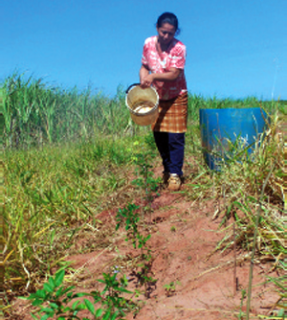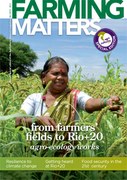Where are we? Where are we going? – Twenty years after the first Earth Summit in 1992, Rio de Janeiro is hosting another major UN conference. This provides an opportunity to look at the progress achieved and to discuss the issues that have emerged in recent years.

This time, the underlying themes of the conference are a “green economy”, in the context of sustainable development and poverty eradication, and the institutional framework needed for sustainable development. Since the conference was first announced, however, many people have been wondering if it makes sense to organise another Earth Summit as we still have not fulfilled the commitments of the previous two.
Also, many fear that the focus on a “green economy” implies neglecting the multiple aspects of sustainable development. The doubts expressed by many “Rio pessimists” have been balanced by the statements of the “Rio optimists”, like UN Secretary General Ban Ki-Moon, who see this as a “once-in-a-generation opportunity”.
The Zero Draft of the outcome document of the conference was presented in January 2012, again provoking a backlash. Many were disappointed with the vagueness of the document, the lack of commitments for making radical changes and the omission of several important issues, including any reference to agro-ecology as a sustainable alternative to conventional agriculture.
Family farmers’ organisations were happy to see the inclusion of a proposal to remove harmful subsidies from conventional agriculture, but criticised the text for avoiding serious discussion about the major problems facing agricultural systems today.
Civil society organisations have been actively involved throughout the preparatory process leading up to the conference. However, as it became clear that the output document of the conference is not likely to deliver serious commitments, many organisations started to step out of the official process and sought alternative paths for promoting their agendas.
Gradually, many actors have realised that it may be possible to achieve more by participating in the processes outside the official negotiations and have shifted their focus to the parallel side-events that will be organised and to building coalitions with other organisations with the aim of ensuring that the discussions will continue long after the conference is over. In particular, many organisations place their hopes in the process of contributing to defining the Sustainable Development Goals that are likely to replace the Millennium Development Goals after 2015.
Is it really green?
The benefits of agro-ecology are numerous
Just a few days before the conference, the meaning of a “green economy” is still being contested. UNEP describes a green economy as a system of economic activities related to the production, distribution and consumption of goods and services that result in improved human wellbeing over the long term, while not exposing future generations to significant environmental risks or ecological scarcities. However, this definition is open to many interpretations. National governments and the UN agencies tend to support modest changes within the existing economic systems, focusing on technological solutions and policies to promote “sustainable growth”.
Yet, many civil organisations call for more radical measures, and insist that a transformation of the entire economic system is necessary. They advocate a radical “paradigm shift” and new economic models that put the environmental and social dimensions of development at the centre. The main question, however, is if we need new ideas, or if we should rather look at solutions that are already in place, and which recognise the potential of the alternative systems that have been developed over the years.
The debate over the future of agriculture illustrates this discussion well. There is a consensus that agriculture production has to become more sustainable, and that small-scale farmers, especially rural women, need to be acknowledged and receive more support. Yet, views on how to achieve sustainable production are strongly polarised. One model proposes “sustainable intensification” and looks to the development and dissemination of genetically modified seeds and farm mechanisation. The supporters of this model do not see any need for a major transformation of “conventional” agriculture system, which they claim just needs improving. Proponents of the alternative model call for a transition from conventional, input-based agriculture to agricultural practices based on agro-ecological approaches. This will require a change in the current way of thinking about food production which is based on a globalised food system and on large-scale, inputbased farming practices.
Instead of investing time and energy in “improving” conventional farming systems, we should explore the potential of an alternative model and adopt a more holistic approach to farm management.
Is this such a new idea?
Many civil society organisations advocate scaling up agroecological approaches and often refer to the IAASTD report, arguing that this could provide a solution to many problems currently facing the world. The Time to Act Manifesto, signed by civil society organisations from all over the world, argues that agro-ecological agriculture can produce enough food to feed a growing human population and contribute to the creation of fairer, more equitable, social systems.
To many this might come as a surprise, or as “news”. However, agricultural transitions towards more sustainable systems have been going on for a very long time. For more than 27 years, the organisations which make up the AgriCultures network have been collecting and sharing evidence that supports these claims. Our magazines regularly present concrete experiences of farm families and communities which show that agro-ecology and sustainable agriculture are at the centre of development.
The benefits of agro-ecology are numerous: a holistic management leads to balanced farms systems that produce sufficient yields while taking care of the environment. Agroecological systems are less polluting and richer in terms of biodiversity. They maintain ecosystem services and preserve local resources. Moreover, they can contribute to poverty reduction.
The vast majority of the world’s farmers, the small-scale farmers who are the victims of the policies geared towards conventional agriculture, benefit the most from agro-ecology. The enormous amount of evidence that we have found over the years only strengthens our conviction that a healthy food production system is the basis for sustainable development.
In this issue of our magazines we look at how agricultural practices are linked with food security, climate change, energy and poverty. These are the four issues that the Zero Draft of the outcome document has identified as the priority areas. We make an attempt to picture the benefits of an agro-ecological farming system from these four perspectives, building on the extensive evidence gathered over more than 25 years.
The articles in this issue show the need for scaling-up alternative approaches, and what could be the steps in the process. This idea is not new. Now is the time to make it happen!
Text: Marta Dabrowska
Marta Dabrowska is a specialist in development and rural innovation. She has co-ordinated the Rio+20 preparatory process for ILEIA and the AgriCultures Network.
E-mail: m.i.dabrowska@gmail.com


